Leyendecker
C. J. Leyendecker was a popular early 20th century illustrator. He produced several recognizable images for the B.S.A., and a few of them made their way onto postcards.
Weapons For Liberty (Third Liberty Loan Campaign)
After the outbreak of World War I, the Boy Scouts of America were offered and accepted the responsibility of raising funds during each of the Liberty Loan drives. Many Scouting historians agree with Murray, who in his 1935 History of the Boy Scouts of America, said "One of the most exciting tasks given the Scouts, was for them to sell Liberty Bonds after the regular canvassers had covered the field. They literally were to be the gleaners after the reapers. Their achievements exceeded all expectations. In the five Liberty Loans, the Boy Scouts secured subscriptions for a total of $352,122,973 worth of Bonds. . . ."
To assist the Scouts for the Third Liberty Loan Drive, he created his now familiar poster.
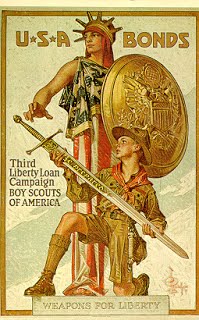
The art work was used as the basis of the March 2, 1918 Saturday Evening Post.
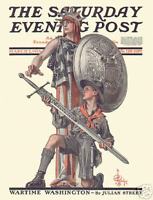
Two weeks later it appeared in reduced size in black and white on the cover of the March 15th issue of Scouting Magazine in which the Boy Scouts laid out the details of the organization for the Third Liberty Loan Drive.
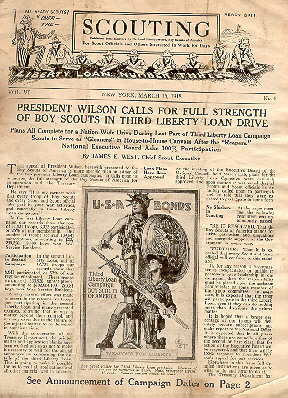
As campaign aids, the Boy Scouts of America made available electrotype "cuts" such as the one used on the cover of Scouting Magazine seen above. At a nominal cost they also provided mats, newspaper screen, and colored lantern slides to Local Councils, Troops, or individual Scouts who wanted to use them to help promote the bond drive.
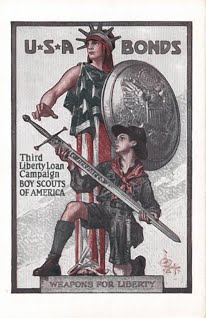
In addition to all of these, the poster was made available in postcard form in shades of red and black on a white card.
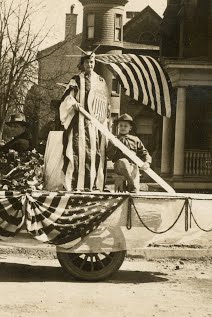
On at least one occasion, for a 1918 parade to honor service personnel and raise funds for the Liberty Loan in Poughkeepsie, New York, a float portrayed the Weapons for Liberty poster and was captured on at least two different real photo postcards.
The Collectibles
Posters - Be careful. The originals were 20 inches by 30 inches. Many have since been mounted on linen by competent conservators who do good repairs to torn edges and can even fill holes so that they are almost undetectable. The author believes that whereas a good repair job enhances the value, a poor job detracts from the poster. If it seems too good to be real, it's probably not an original. Originals seem to sell for $175 to $450 depending on condition and framing. If someone offers you one for $25 make sure you know who they are. (See modern reproductions, below.) As with everything else, buy from a reputable dealer.
Postcards. Even though they were sold to the fund raisers at $10 per thousand, the original 1918 cards are extremely rare. They were printed using red and black ink only. If the shield has a gold tone, the card was produced after 1918. The author has seen only two originals offered on internet auction sites since their inception.
Saturday Evening Post, March 2, 1918.
Scouting Magazine, March 15, 1918.
Lantern Slides.
Printing aids: mats, screens, copper printing blocks.
Newer items. Leyendecker's striking patriotic image remains popular. It is possible to find and collect newer items that retain the original appeal. Just be aware of what you are buying.
Postcards:
In the 1960s The Boy Scouts of America reprinted the original postcard, but this time in full color. It maintained the star-studded background of the 1918 card.
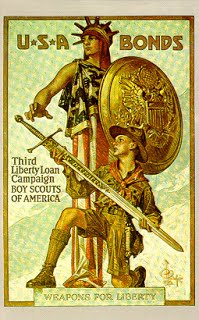

Shortly thereafter, the National Archives published a postcard of one of the posters in its collection. The background of this card, like the posters, has a swirling, cloud-like quality.
With the image entering the public domain, it was reproduced by the Madison Square Press as a continental size card (4 x 6 inches as compared to the original standard size, 3 3/8 x 5 3/8 inches.)
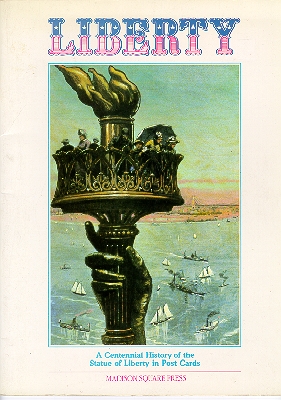

Madison Square Press also included the card in a book of tear-out postcards featuring the Statue of Liberty. This card, when found individually, is perforated on the left and bottom.
Dover included a similar continental card in a book of reproduction postcards.
The card was also reproduced in continental size by Mayfair Postcards in the U.K.
None of the continental cards are particularly difficult to find.
Posters:
The original poster has been reproduced many times in various sizes from 5 x 7.5 inches on up. The quality of the printing and the quality of the paper varies widely. Since anyone today can "swipe" an image from the internet and print it on glossy paper, the best advice is to ask questions of the vendor, and check their reputation.